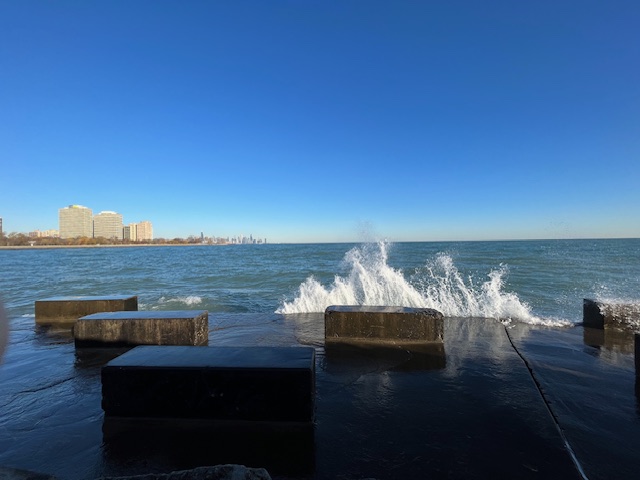HAIKAST XI – On The Verge
One of my favorite words is verge. It is one of those fun words that can be either a noun or verb. I first gained a deeper appreciation for its meaning when reading a book about landscapes. In that book, verge was described as a place that delineated the border of human made space and natural space. The leading example was of beachfront properties, describing how humans often desire to build sophisticated infrastructure as close to wild places as possible. So a coastline could be a verge – a transition space between the inevitable wild and the human built.
Another use of the word verge is the green space between a street and sidewalk. In this case, it is a highly controlled natural zone in the streetscape. Other terms used for that zone are berm, curb strip, swale, grass strip, terrace, green belt, tree bank, street lawn, sidewalk plot, etc. When I visited Portland, a town that does an incredible job of landscaping with diverse plantings in that zone, they refer to them as “hell strips.”
In this zone, the verge is technically, and very importantly, the right-of-way. Say “right-of-way” 5 times fast and you’ll begin to wonder how it ever got that civic definition. Whose right? What way? It would probably be more accurate to call it a no-mans-land. Often, the sidewalk verge is an example of what is essentially the public commons gone wrong – either bare minimum treatment of weeds OR an immaculate fertilized and herbicide-fed turf grass that noone ever uses except to spend a few minutes burning fossil fuels to mow. A chemical dump.
How many verge acres are there when adding up thousands of small square foot patches in this country?
In my personal experience with a sidewalk verge, I was a volunteer leader for the landscape at my church (a former warehouse packed into a dense downtown neighborhood) that was surrounded by asphalt. Before I took on the role, there was no one doing it. I daresay that no one even thought it was a needed role because it was a weed covered hell strip next to a building that we did not own. This verge was practically invisible.
I proposed a raised bed in the verge. With some TLC, it became a mini-rose garden at the side entrance of our nondescript rag tag church. A year later, Toni Costanzi, who helped us build the bed, passed away. She was the first person from the relatively young church who had a funeral in the building, so we put a memorial sign at the corner of the bed. It was truly beautiful. A little bit of heaven on that strip.
In the following three years, with some serendipitous support from local Indiana University Professor Kevin Lair, 100 linear feet of native flowers, grasses, shrubs, and trees were planted in front of the building. A section was designated as a neighborhood garden with a sign that encouraged walkers to take some food as they strolled down Sycamore St. The verge came to life. It was my introduction into native plants and forever changed my understanding of the value of ecological diversity.
There are other verges – the verb variety. Instead of a gray line of delineation, a verge can be more about decision making, at the cusp of a transition in one’s life. It can be about connecting with a new opportunity.
People say they are “on the verge,” like walking towards the precipice of a monumental life decision. To verge can be like walking from the known into the unknown – facing all the pressure that comes from making a leap towards a new life.
Verges can be thwarted by outside forces – like being on the verge to victory, only to have the ball bounce the wrong way on the road to defeat. Or you can di-verge and decide to go a different way from where you had expected.
In 2023, I attempted to verge into City Council political life. I walked into the Election Day party ahead in the polls, only to see my lead dwindle and then slip away at the last moment. I was on the verge to a new path in life and then I lost. The verge line between the public life of an elected official and the wild life of the general public grew very thin in November. In my ongoing advocacy work, I will remain near that edge, that gray space where private citizens try to influence public officials. Hugging close to that line is what I think of as democracy, as we all play a part that can go well beyond our time in the voting booth.
The day after I lost the election, I drove to Chicago for work. The timing was very helpful as I decompressed from 4 months of feverish activity. The first morning in the city, I woke up early, grabbed a cup of coffee, and walked straight to the shores of Lake Michigan. There, at Promontory Point near Hyde Park, I walked out towards the large hewn stones that formed a bulwark against the crashing waves. I was mesmerized. The skyline unfolded north of me. That crisp morning, I climbed down the rock until I was dangerously close to the spray of the water mist. I started taking pictures. Why was I doing this? I was enthralled by the rock in foreground, the stop action of a crashing wave caught at its apex, and the skyline in the background.
They weren’t great pictures. It’s impossible to catch the immanence of that place or the feeling that I had that morning – the proximity to unpredictable nature on the Chicago metropolis shore.
I had found a verge.
I danced on the stones as long as I could before I needed to leave to meet my colleagues.
Found verge at rock wall
Lake waves crash on hand hewn stone
Lawn then trail then road


Recent Comments